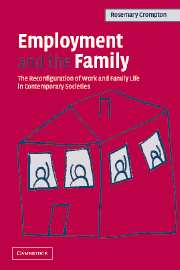Book contents
- Frontmatter
- Contents
- Preface
- 1 Understanding change in employment, family and gender relations
- 2 Caring and working
- 3 Women, men, organisations and careers
- 4 Work–life articulation, working hours and work–life policies
- 5 States, families and work–life articulation
- 6 Households, domestic work, market work and happiness
- 7 Class, family choices and women's employment
- 8 Conclusions
- Appendix A Additional ISSP Family 2002 questions
- Appendix B Joseph Rowntree Foundation (JRF) interviewees cited
- Bibliography
- Index
1 - Understanding change in employment, family and gender relations
Published online by Cambridge University Press: 22 September 2009
- Frontmatter
- Contents
- Preface
- 1 Understanding change in employment, family and gender relations
- 2 Caring and working
- 3 Women, men, organisations and careers
- 4 Work–life articulation, working hours and work–life policies
- 5 States, families and work–life articulation
- 6 Households, domestic work, market work and happiness
- 7 Class, family choices and women's employment
- 8 Conclusions
- Appendix A Additional ISSP Family 2002 questions
- Appendix B Joseph Rowntree Foundation (JRF) interviewees cited
- Bibliography
- Index
Summary
All fixed, fast frozen relations, with their train of ancient and venerable prejudices and opinions, are swept away, all new-formed ones become antiquated before they can ossify. All that is solid melts into air …
(Marx and Engels, Manifesto of the Communist Party 1848)Man for the field and woman for the hearth
Man for the sword and for the needle she
Man with the head and woman with the heart
Man to command and woman to obey
All else confusion.
(Tennyson, ‘The Princess’ 1847)Introduction
These well-known quotations serve to convey two themes that are central to this book: first, that rapid social change is endemic in modern societies, but nevertheless, that sexual differences, as expressed in gender relations, are characterised by both change and continuity. We do not lack attempts that seek to develop totalising accounts of global social change (for example, Castells' (1997) three-volume Information Age), but, in this book, we focus on a particular ‘slice’ of this totality, that is, the inter-relationships between men, women, families and employment. However, this ‘slice’ will be (and will always have been) crucially affected by wider normative, political and economic contexts and the manner of their development. In order to understand the present, we have first to understand the past.
The growth of capitalist industrialism from the end of the eighteenth century was accompanied by technical innovation, the development of the factory system, and the expansion of independent wage labour, which required individuals to be freed from traditional restraints on their mobility and employment opportunities.
- Type
- Chapter
- Information
- Employment and the FamilyThe Reconfiguration of Work and Family Life in Contemporary Societies, pp. 1 - 30Publisher: Cambridge University PressPrint publication year: 2006



